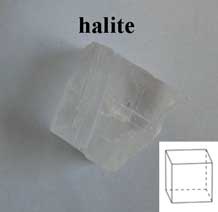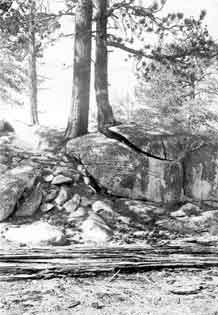Science Background
Learn more about Earth Materials:
What is a mineral?
You’ve met seven minerals that we frequently find in rocks, including feldspar, mica, and quartz, the most common mineral on Earth. There are thousands of other minerals on Earth, including gems like diamonds and emeralds, and metals like gold and copper. People have found thousands of different ways to make use of Earth's minerals. We use talc in baby powder. We season our food with halite (salt). The clay mineral kaolinite is used in pottery, but you might also find kaolinite in the ingredients list for ice cream — it’s used to keep ice cream from melting quickly.

All of the substances that we call minerals occur in nature. You can see feldspar, mica and quartz in granite rocks. If a substance is manmade, like plastic or steel, it’s not a mineral. To be classified as a mineral, a substance must be a solid. That rules out water (a liquid) but ice (the same stuff in solid form) is a mineral. When a mineral crystallizes, its particles come together in a 3–dimensional pattern that's repeated in all directions, known as a crystal structure. The shape of the crystals may be intricate, like a snowflake, or may be as simple as a cube.
Mineral crystalsMineral crystals form in several different ways. Water crystallizes when it freezes. Hot liquid magma crystallizes when it cools. Minerals crystallize in granite when magma cools slowly, deep underground. Salt minerals, on the other hand, form when salty water evaporates, leaving behind deposits of rock salt. Sometimes, when rock particles are heated they rearrange themselves to form a new crystal structure and become new minerals, with new properties.
Properties of mineralsThe properties of minerals, such as hardness, color and heaviness for size, give us clues about their composition and their crystal structure and help us identify them. Diamonds are the hardest minerals by far and you cannot scratch them with other minerals. When you break off a piece of halite you may find squared–off corners, reflecting the repeating cubes of its crystal structure. Mica crystals, on the other hand, form in sheets, and you'll find that it breaks along flat surfaces. You can tell hematite apart from other dark colored minerals because it is heavy for its size and magnetic.
Weathering

Uplift of rock by growth of tree roots,
Sierra Nevada, California
Credit: U.S. Geological Survey
Department of the Interior/USGS
Photo by G.K. Gilbert
When you look at sand, you may see tiny pieces of quartz in the sand that match large pieces of quartz rocks nearby, and you may see tiny pieces of shiny mica that match larger piece of mica. Small pieces of rocks and minerals are always wearing off and breaking off larger pieces, and those small pieces themselves wear down and break into smaller pieces.
What causes this to happen? Rivers and oceans roll rocks and minerals across one another thousands or millions of times, and wind and storms and other natural forces on earth keep moving and grinding earth materials into smaller and smaller pieces.

When rainwater gets into rocks and then freezes, it expands and can cause pieces of rock to break off. Plant roots may also expand in cracks and cause pieces of rock to break off. When acid rain falls on limestone or chalk, over a long period of time, the material breaks down. The name used to describe this wearing down of Earth materials on the Earth's surface is weathering, although weather is just one of the forces that makes things break down into smaller pieces.
Earth materials that have been loosened by weathering may move, carried by air, water or ice, or carried downhill by gravity. The name used to describe this movement is erosion.



